The Snowman
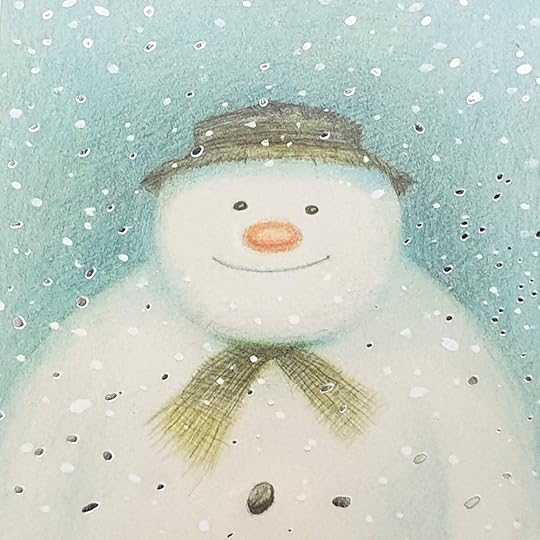 The Snowman by Raymond Briggs(Hamish Hamilton, 1978)Good to Read for:Winter magicencouraging storytelling skillscreating calmFew picture books evoke Christmas more than the timeless classic, The Snowman by Raymond Briggs (Hamish Hamilton, 1978).
The Snowman by Raymond Briggs(Hamish Hamilton, 1978)Good to Read for:Winter magicencouraging storytelling skillscreating calmFew picture books evoke Christmas more than the timeless classic, The Snowman by Raymond Briggs (Hamish Hamilton, 1978). Which is funny. Because the picture book (unlike the animated short film) doesn’t reference Christmas at all. There’s no trip to the North Pole. No Father Christmas. Not even a Christmas tree!
The story was inspired by the heaviest snow Briggs had ever seen. “Snow had fallen steadily all night long,” he recalls, “and in the morning I woke in a room filled with light and silence, the whole world seemed to be held in a dream-like stillness. It was a magical day… and it was on that day I made The Snowman.”
Briggs captures that magical day in a story told entirely through pictures. Lots and lots of them, working together sequentially in a style once regarded as ‘comic’ format, now elevated to the ranks of ‘graphic novel.’ (In a BBC Newsnight interview, he admits to disliking the term. “But [it] makes it sound posher which sells more, I suppose.”)
Believe it or not, wordless picture books are great for your child. They empower pre-readers (i.e. Children who are unable to read words), allowing them to step into the role of storyteller. Because if there are no words to fluff, then they can’t get it wrong! (I write more about the power of silent picture books in my reviews of Fox’s Garden and Hike.)
I remember sharing The Snowman with my kids when they were young. It was a very different experience to reading a picture book with words. It was calming and created a peaceful atmosphere (great for over-excited kids!). It somehow slowed everything down as we moved from panel to panel, searching the pictures for meaning and narrative (rather than breezing through a written story). You can sense that ‘dream-like stillness’ which enchanted Briggs on that snowy morning. In other words (to quote Posy Simmonds), The Snowman is “as quiet as when it snows.”
Even when Briggs shows how restless the boy feels at bedtime (knowing that his snowman – and all that wonderful snow! – is outside), it feels subdued. A small bedside clock shows the passing of time as the boy tosses and turns, unable to get the snowman off his mind. Finally, at 1am, he puts on his dressing gown, creeps downstairs and opens the backdoor – only to discover the Snowman, fully alive and tipping his hat in greeting. I still find that a magical moment!
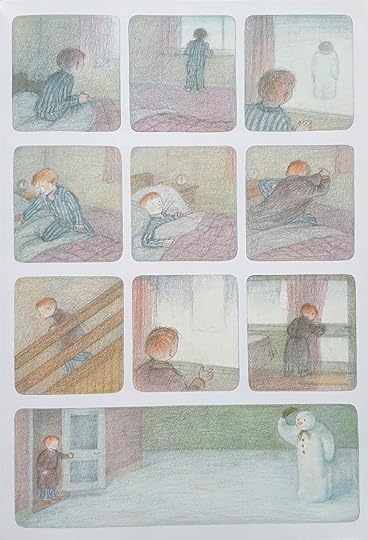
The boy invites his new friend inside. The Snowman enjoys exploring (I especially like his fascination with switching lights on and off!), and they fool around together.
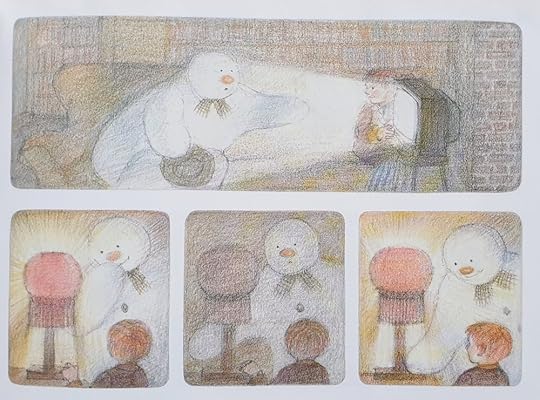
The Snowman is a great book for inspiring creativity and getting your little ones to tell their own tales. Prompt them with questions like, What might a snowman do in our house? What dangers will he need to watch out for?
(Speaking of which – I could never figure out why the painting of van Gogh’s Sunflowers makes the Snowman so sad. But it just occurred to me – it’s because they represent the ultimate heat source: the sun!)
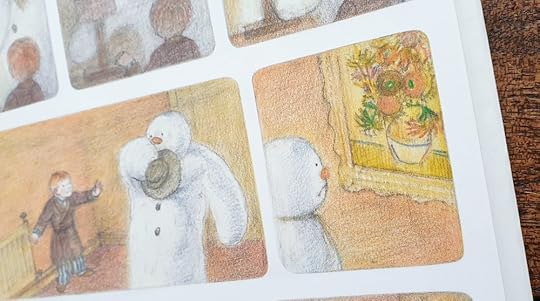
The Snowman takes some time out to relax in the chest freezer (I suspect a publisher would veto that scenario now), after which the new friends sit down to a candlelit supper.
[image error]But everyone knows: a house is no place for a snowman. So they go outside (Briggs contrasts the warmth of home with the wintry landscape outside beautifully) – and that’s where the magic really begins.
Taking the boys hand, the Snowman runs down the garden and takes off, flying up into the night sky.
[image error]After pages of small, panelled pictures, I love how Briggs gives us two big double spreads. They help emphasise the open expanse of the landscape and offer an extended moment to pause and relish the magic.
One snowman, one boy. Flying hand in hand over the snowy Sussex landscape.
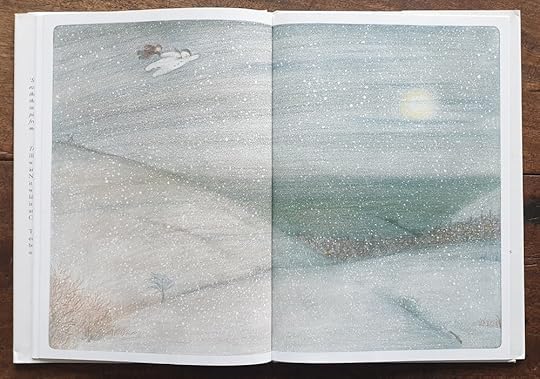
(The Snowman was inspired by that snowy morning at Briggs’s home in Westmeston, Sussex (UK). So it’s appropriate that the Snowman and the boy fly along the coast to Brighton, where they soar over the exotic-looking Royal Pavilion before landing on the Palace Pier.)
[image error]As they look out at sea, the first splash of colour on the horizon signals daybreak. The Snowman, visibly troubled, once again takes the boys hand. It’s time to fly home.
Because like in Cinderella, once the clock chimes a particular hour, the magic will end.
Back in the garden, the friends hug. It is a sad moment, and you sense how reluctant they are to say farewell. Finally, after many backward glances, the boy goes back to bed, fitfully sleeping until the morning.
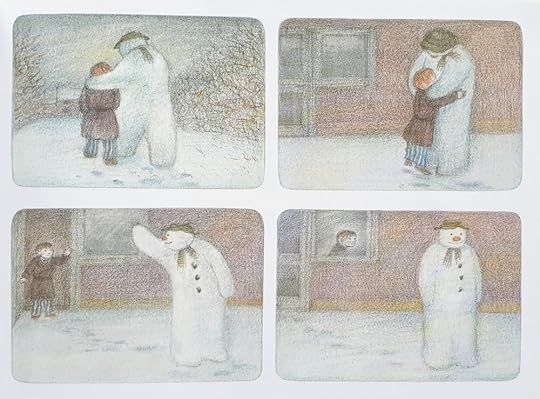
The official website sums up The Snowman rather nicely as a ‘timeless and magical tale [that] tells a story of imagination and friendship as well as love and loss.’
And it’s that combination – of love and loss – that make The Snowman so poignant and bittersweet. Many adults object to the inevitable melting away (effectively, the death of) the Snowman at the end of the book.
Seeing the boy rush downstairs, past his parents at the breakfast table – to discover what’s left of his friend -comes as quite a shock, even now. A hat, a scarf and some lumps of coal perched on a small mound of snow.
Trinkets left at a freshly dug grave.
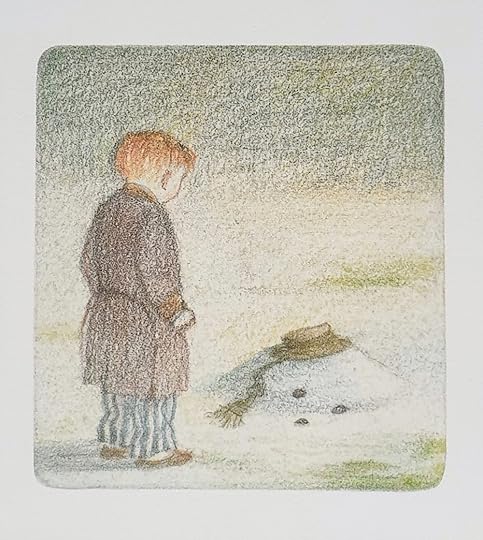
But that was the whole point. Briggs never intended The Snowman to be a jolly Christmas story. (Those elements were introduced in the animated adaptation that is so ingrained in our psyche.) He intended it to be about death all along.
“I don’t have happy endings,” Briggs told The Radio Times. “I create what seems natural and inevitable. The Snowman melts, my parents died, animals die, flowers die. Everything does. There’s nothing particularly gloomy about it; it’s a fact of life.”
Personally, I think the safe confines of a picture book is just the place to initiate such difficult conversations. Briggs is right. Sooner or later, a child will experience death – be it of a loved friend or family member, pet or maybe something the cat drags in. And they probably feel a lot less uncomfortable about it than us adults do.
On the other hand, many kids will take it at face value.
Snow comes.
Snow goes.
Seasons change.
Life goes on.
Here in the UK, it rarely snows at Christmas. But at least we can depend on Channel 4 to broadcast The Snowman. It has all the quiet magic – and sad ending – of the picture book. And as an added bonus, it comes complete with Christmas trimmings.
STORIES WORTH SHARINGThe Snowman by Raymond Briggs(Hamish Hamilton, 1978)Good to Read for:Winter magicencouraging storytelling skillsdeveloping visual literacyIllustrations © 1978 by Raymond BriggsGOOD TO READWordless Picture booksClown by Quentin Blake
The Snowman by Raymond Briggs
Fox’s Garden by Princesse Camcam
Hike by Pete Oswald
The Chicken Thief by Béatrice Rodriguez
(Almost) wordless picture booksHug by Jez Alborough
Banana by Ed Vere
BUY THE BOOKPowered by Bookshop.org
Supporting independent bookshops
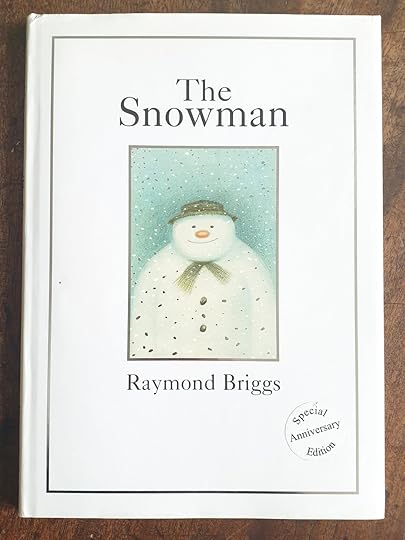
“As quiet as when it snows.”
– Posy Simmonds“Extraordinary and atmospheric.”
– Booktrust Buy UK buy us * I EARN COMMISSION FROM THESE LINKS #AD/AFFRELATED ARTICLESSOURCES Raymond Briggs Speaks About His Most Popular Books (Rowan Jones, 18 January 2018) Why I'd like to be a proper author (Raymond Briggs, The Guardian, 2 November 2002) The Snowman (thesnowman.com) Raymond Briggs: Snowmen, Bogeymen & Milkmen review – a timely look at an eccentric life (Tim Dowling, The Guardian, 31 December 2018) Interview with Raymond Briggs (Emma Chaplain, 9 August 2012) The surprising stories behind your favourite children's Christmas classics (Alice Vincent, penguin.co.uk, 17 December 2021)© 2021 BY TIM WARNES(UNLESS OTHERWISE ATTRIBUTED)****USE OF THIRD PARTY COPYRIGHTED MATERIAL FALLS UNDER FAIR USE/FAIR DEALING PRACTICE.My Life in Books
For lovers of kid lit, this memoir - My Life in Books - is intended to give you the confidence and encouragement to share your own passion; to help you make lasting connections through kids’ books.
Originally posted at www.timwarnes.com ...more
- Tim Warnes's profile
- 30 followers



